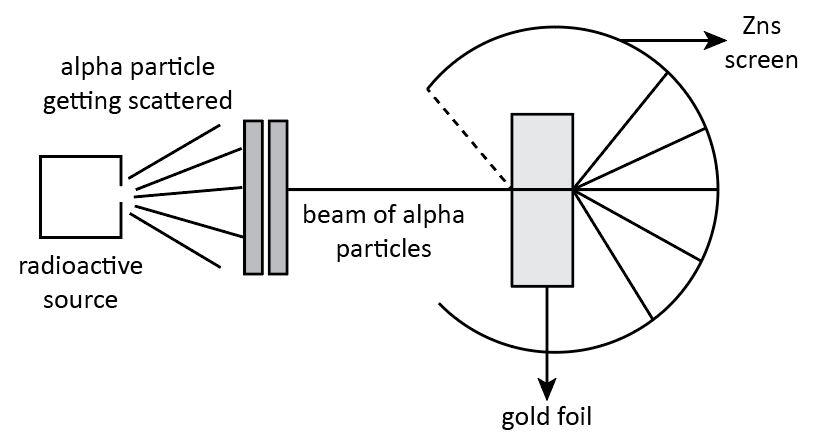
Rutherford’s
A. electrons
B. protons
C. neutrons
D. atomic nucleus
Answer
492.9k+ views
1 likes
Hint: We know that, according to the model of an atom, the nucleus is positively charged due to the presence of protons in it and the negatively charged electrons revolve around it in a fixed circular orbit like planets spin around the sun.
Complete step by step solution:
We know that an atom is composed of three component particles which are electrons, protons and neutrons. The protons and neutrons are situated in the nucleus of an atom. However, the electrons are distributed uniformly outside the nucleus. There is no overall charge on an atom. This theory was proposed by Ernest Rutherford. Let’s discuss it in detail.
According to Rutherford, an atom is composed of a nucleus which is positively charged and the negatively charged electrons revolve around it in a fixed circular orbit. This conclusion was put forward on the basis of his scattering experiment.
The experiment performed by Rutherford gave important observations about an atom.
1. The first observations of the alpha particle scattering experiment explains that most of the alpha particles passed straight from the foil without any failure in their direction. This observation confirms that there must be sufficient free space within the atom.
2. The second observation states that most of the alpha particles undergo deflection. Some particles experience small deflection whereas some particles experience large deflection. This observation confirms that there must be a positively charged body in an atom due to which the positively charged alpha particles experience repulsive force which lead to the small and large deflection. This confirms the presence of a heavy positively charged nucleus in the center of the atom.

Hence, we can say that Rutherford's
Thus, the correct option is D.
Note:
As we know that, the mass and properties of all the atoms present in an element are identical. After the discovery of atoms, the different subatomic particles were also discovered by various experiments done by scientists. In the year,
Complete step by step solution:
We know that an atom is composed of three component particles which are electrons, protons and neutrons. The protons and neutrons are situated in the nucleus of an atom. However, the electrons are distributed uniformly outside the nucleus. There is no overall charge on an atom. This theory was proposed by Ernest Rutherford. Let’s discuss it in detail.
According to Rutherford, an atom is composed of a nucleus which is positively charged and the negatively charged electrons revolve around it in a fixed circular orbit. This conclusion was put forward on the basis of his scattering experiment.
The experiment performed by Rutherford gave important observations about an atom.
1. The first observations of the alpha particle scattering experiment explains that most of the alpha particles passed straight from the foil without any failure in their direction. This observation confirms that there must be sufficient free space within the atom.
2. The second observation states that most of the alpha particles undergo deflection. Some particles experience small deflection whereas some particles experience large deflection. This observation confirms that there must be a positively charged body in an atom due to which the positively charged alpha particles experience repulsive force which lead to the small and large deflection. This confirms the presence of a heavy positively charged nucleus in the center of the atom.

Hence, we can say that Rutherford's
Thus, the correct option is D.
Note:
As we know that, the mass and properties of all the atoms present in an element are identical. After the discovery of atoms, the different subatomic particles were also discovered by various experiments done by scientists. In the year,
Latest Vedantu courses for you
Grade 11 Science PCM | CBSE | SCHOOL | English
CBSE (2025-26)
School Full course for CBSE students
₹41,848 per year
Recently Updated Pages
Master Class 10 General Knowledge: Engaging Questions & Answers for Success

Master Class 10 Computer Science: Engaging Questions & Answers for Success

Master Class 10 Science: Engaging Questions & Answers for Success

Master Class 10 Social Science: Engaging Questions & Answers for Success

Master Class 10 Maths: Engaging Questions & Answers for Success

Master Class 10 English: Engaging Questions & Answers for Success

Trending doubts
A boat goes 24 km upstream and 28 km downstream in class 10 maths CBSE

Why is there a time difference of about 5 hours between class 10 social science CBSE

The Equation xxx + 2 is Satisfied when x is Equal to Class 10 Maths

Chandigarh is the capital of A Punjab B Haryana C Punjab class 10 social science CBSE

Change the following sentences into negative and interrogative class 10 english CBSE

Discuss the main reasons for poverty in India




